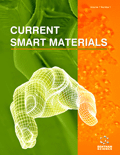Abstract
Background: Layered inorganic materials are important candidates as smart electrorheological (ER) materials because of their low cost and anisotropic morphology. However, the ER effect of most of layered materials is too weak to satisfy the requirement of applications. This paper reported a new kind of layered ER material based on polyaniline-intercalated titanate nanoplates (PANITNP). We presented the preparation, structure characterization, and rheological measurement. And finally we conducted dielectric spectra to analyze the mechanism of enhanced ER effect after intercalation of conducting PANI into TNP.
Methods: An intercalation chemical process was used to prepare the aniline-intercalated titanate nanoplates and then an oxidative polymerization was further employed to prepare PANI-TNP. Different techniques including scanning electron microscopy, X-ray powder diffraction, Fourier transform infrared spectrometer, thermogravimetric analysis were used to analyze the morphology, structure and thermal properties of samples. A stress-controlled electro-rheolometer was used to measure the rheological curve of PANI-TNP ER suspensions. Two-point method was used to measure the DC conductivity. An impedance analyzer was used to analyze the dielectric spectra. Results: The structure characterization showed that the PANI-TNP possessed 100 nm thickness and 500-1000 nm lateral size, and PANI was intercalated into the interlayer of layered titanate with weight content of ~ 9%. Under electric fields, the investigation about rheological properties of suspension containing PANI-TNP showed that the PANI-TNP suspension exhibited significantly higher ER effect compared to the suspensions containing pure TNP. At the same electric field, the shear stress and ER efficiency of PANI-TNP suspension was 2.5 times and 7 times as high as those of pure TNP suspension. The dielectric measurements indicated that the intercalation of conducting PANI into TNP significantly improved particle polarization, which was in accordance with its enhanced ER effect. Conclusion: To enhance ER effect of layered materials, this paper developed a kind of polyanilineintercalated titanate nanoplates (PANI-TNP). The intercalation of conducting polyaniline into TNP could significantly improve the particle polarization and this results in the enhancement of ER effect of TNP.Keywords: Dielectric spectra, electrorheology, intercalation, polyaniline, rheological property, titanate nanoplate.
Graphical Abstract
 18
18


